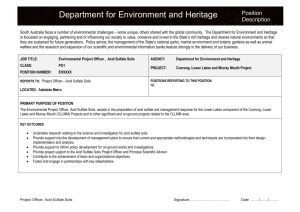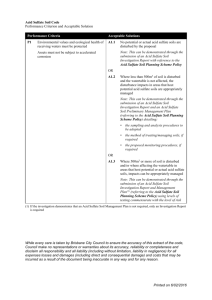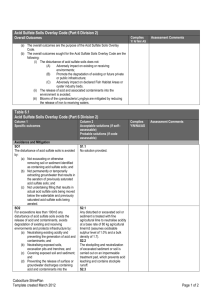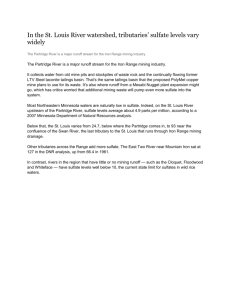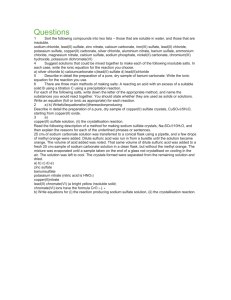Potential and actual acid sulfate soils overlay code
advertisement
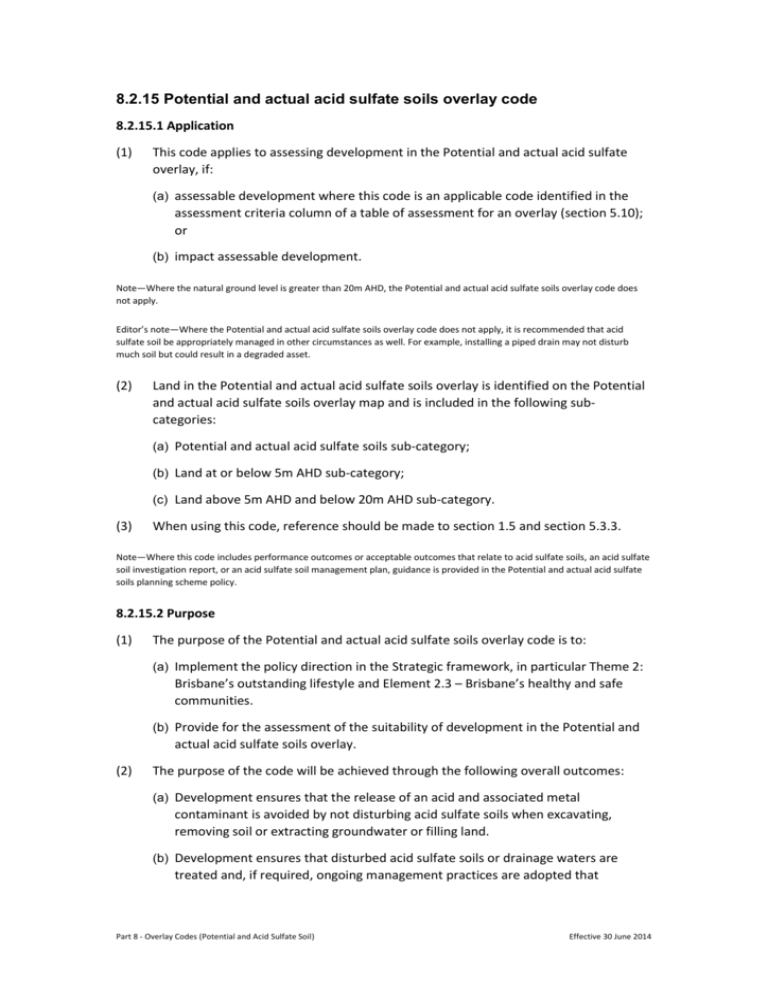
8.2.15 Potential and actual acid sulfate soils overlay code 8.2.15.1 Application (1) This code applies to assessing development in the Potential and actual acid sulfate overlay, if: (a) assessable development where this code is an applicable code identified in the assessment criteria column of a table of assessment for an overlay (section 5.10); or (b) impact assessable development. Note—Where the natural ground level is greater than 20m AHD, the Potential and actual acid sulfate soils overlay code does not apply. Editor’s note—Where the Potential and actual acid sulfate soils overlay code does not apply, it is recommended that acid sulfate soil be appropriately managed in other circumstances as well. For example, installing a piped drain may not disturb much soil but could result in a degraded asset. (2) Land in the Potential and actual acid sulfate soils overlay is identified on the Potential and actual acid sulfate soils overlay map and is included in the following subcategories: (a) Potential and actual acid sulfate soils sub-category; (b) Land at or below 5m AHD sub-category; (c) Land above 5m AHD and below 20m AHD sub-category. (3) When using this code, reference should be made to section 1.5 and section 5.3.3. Note—Where this code includes performance outcomes or acceptable outcomes that relate to acid sulfate soils, an acid sulfate soil investigation report, or an acid sulfate soil management plan, guidance is provided in the Potential and actual acid sulfate soils planning scheme policy. 8.2.15.2 Purpose (1) The purpose of the Potential and actual acid sulfate soils overlay code is to: (a) Implement the policy direction in the Strategic framework, in particular Theme 2: Brisbane’s outstanding lifestyle and Element 2.3 – Brisbane’s healthy and safe communities. (b) Provide for the assessment of the suitability of development in the Potential and actual acid sulfate soils overlay. (2) The purpose of the code will be achieved through the following overall outcomes: (a) Development ensures that the release of an acid and associated metal contaminant is avoided by not disturbing acid sulfate soils when excavating, removing soil or extracting groundwater or filling land. (b) Development ensures that disturbed acid sulfate soils or drainage waters are treated and, if required, ongoing management practices are adopted that Part 8 - Overlay Codes (Potential and Acid Sulfate Soil) Effective 30 June 2014 minimise the potential for environmental harm from acid sulfate soil and protect corrodible assets from acid sulfate soil. (c) Development is located, designed and constructed to avoid the mobilisation and release of iron compounds for coastal algal blooms. 8.2.15.3 Assessment criteria The following table identifies the assessment criteria for assessable development. Table 8.2.15.3—Criteria for assessable development Performance outcomes Acceptable outcomes PO1 AO1 Development protects the environmental values and ecological health of receiving waters and does not subject assets to accelerated corrosion. Development ensures that: (a) no potential or actual acid sulfate soils are disturbed; or Note—This can be demonstrated through the submission of an acid sulfate soil investigation report with reference to the Potential and actual acid sulfate soils planning scheme policy. (b) the disturbance impacts in an area that hosts potential acid sulfate soils are appropriately managed, if less than 500m3 of soil is disturbed and the watertable is not affected; or Note—This can be demonstrated through the submission of an acid sulfate soil investigation report and a preliminary acid sulfate soil management plan, with reference to the Potential and actual acid sulfate soils planning scheme policy. (c) impacts are appropriately managed if 500m3 or more of soil is disturbed or the watertable in an area that hosts potential or actual acid sulfate soils is affected. Note—This can be demonstrated through the submission of an acid sulfate soil investigation report and a full acid sulfate soil management plan, with reference to the Potential and actual acid sulfate soils planning scheme policy using levels of testing commensurate with the level of risk. If the investigation demonstrates that an acid sulfate soil management plan is not required, only an investigation report is required. Part 8 - Overlay Codes (Potential and Acid Sulfate Soil) Effective 30 June 2014

